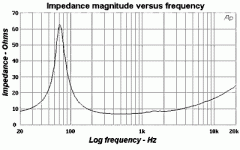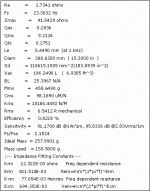I’m choosing woofers to use in my system. There’re questions below.
Woofer A
Impedance: 4 Ohms
DC Resistance: 3.6 Ohms
Woofer B
Impedance: 4 Ohms
DC Resistance: 4.3 Ohms
As can be seen, the DC resistances are different, but the impedances are equal. In operating condition, something might be different. IMHO, The reactance values may be. Therefore, which one is better?
Woofer A
Impedance: 4 Ohms
DC Resistance: 3.6 Ohms
Woofer B
Impedance: 4 Ohms
DC Resistance: 4.3 Ohms
As can be seen, the DC resistances are different, but the impedances are equal. In operating condition, something might be different. IMHO, The reactance values may be. Therefore, which one is better?
Last edited:
Neither is better. They're simply impedance measurements.
DC resistance is the measured value of the woofer voice coil when measured with an ohm meter.
The 4 ohm value is a nominal impedance based on an average of the impedance curve measured across the audible frequency spectrum. It can range from quite low at DC resistance to a large peak at the resonant frequency, to a steadily increasing value as the frequency goes higher. (see an example of an impedance curve below) Notice that it rises to over 60 ohms at around 70hz, drops back down then begins a long slow rise to over 20 ohms at the highest frequencies. The impedance curves will be slightly different between the two woofers, but it tells you very little about how they'll sound. The woofer manufactures typically supply specs that will include the impedance curve. It's useful information when calculating the impedance for crossovers....pay particular attention to the impedance at your chosen crossover point. I like to use a zobel network near the crossover frequency to maintain a constant impedance above the crossover point.
The Thiele/Small parameters frequency curves will tell you a lot more about how they'll behave. Specs that should also be provided by the manufacturer, and are critical calculating box size and type, and woofer response.
Impedance Curve from 20 to 20khz:

Below is an example of the T/S parameters:

DC resistance is the measured value of the woofer voice coil when measured with an ohm meter.
The 4 ohm value is a nominal impedance based on an average of the impedance curve measured across the audible frequency spectrum. It can range from quite low at DC resistance to a large peak at the resonant frequency, to a steadily increasing value as the frequency goes higher. (see an example of an impedance curve below) Notice that it rises to over 60 ohms at around 70hz, drops back down then begins a long slow rise to over 20 ohms at the highest frequencies. The impedance curves will be slightly different between the two woofers, but it tells you very little about how they'll sound. The woofer manufactures typically supply specs that will include the impedance curve. It's useful information when calculating the impedance for crossovers....pay particular attention to the impedance at your chosen crossover point. I like to use a zobel network near the crossover frequency to maintain a constant impedance above the crossover point.
The Thiele/Small parameters frequency curves will tell you a lot more about how they'll behave. Specs that should also be provided by the manufacturer, and are critical calculating box size and type, and woofer response.
Impedance Curve from 20 to 20khz:

Below is an example of the T/S parameters:

Last edited:
The interesting thing is that one woofer has impedance greater than DC resistance, the other vice versa.
If the impedance labeled is the average value, is it possible to assume that the higher DC resistance driver will have flatter impedance curve (less rising impedance at higher frequency)? Because the impedance can be averaged to lower than its DC resistance. For the lower DC resistance driver, it cannot be averaged impedance so low due to its higher impedance at higher frequency.
Sorry for asking so deep in theory, since the drivers are old and not have much data with them.
If the impedance labeled is the average value, is it possible to assume that the higher DC resistance driver will have flatter impedance curve (less rising impedance at higher frequency)? Because the impedance can be averaged to lower than its DC resistance. For the lower DC resistance driver, it cannot be averaged impedance so low due to its higher impedance at higher frequency.
Sorry for asking so deep in theory, since the drivers are old and not have much data with them.
You are searching for things that aren't there. The nominal impedance is just a qualification, it has no physical meaning.
The 'Speaker Impedance And Protection' section here may be of interest:
Impedance, and how it affects audio equipment
Impedance, and how it affects audio equipment
In Thailand you can find from Amorn group JBN 6.5" woofer with original JBL diaphragm for only 150 Baht.
The interesting thing is that one woofer has impedance greater than DC resistance, the other vice versa.
It's not really interesting as such (I suppose it depends what you call interesting); as has been noted, DC resistance is simply a nominal figure typically expressed to whatever is nearest of 4ohm, 8ohm & 16ohm. It's a very loose guide for buyers, no more.
If the impedance labeled is the average value, is it possible to assume that the higher DC resistance driver will have flatter impedance curve (less rising impedance at higher frequency)?
Unfortunately not.
- Home
- Loudspeakers
- Multi-Way
- What’s different between the two?